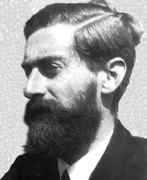Person: Escher, Maurits Cornelius

Escher is an artist whose works have included a considerable mathematical content.
Mathematical Profile (Excerpt):
- Maurits attended both elementary and secondary school in Arnhem between 1912 and 1918, where he failed to shine in many of his subjects, but exhibited an early interest in both music and carpentry.
- Unable and unwilling to catch up following poor health, Maurits decided to concentrate on his drawing and his woodcut techniques.
- A chance meeting with Samuel Jesserum de Mesquita, a graphic arts teacher, proved a landmark event in Escher's life and he became convinced that a graphic arts programme would be better suited to his skills.
- De Mesquita taught the eager Escher all he knew of woodcut printing techniques, gave him space to experiment, and encouraged him to experiment widely in order to develop his skills.
- Escher was regularly heard to complain about his lack of natural drawing ability and as a result most of his pieces took a long time to complete, and required numerous attempts before he was completely happy.
- Escher then spent a further month travelling alone around Italy gathering material to use in his experimental woodcuts.
- During his early drawing career Escher touched only briefly on the subject of 'filling the plane', signs of which had been visible from an early age.
- Unlike the Moors, Escher was both keen and permitted to use recognisable objects in his ad-hoc versions of the tilings.
- Following his return from Spain, Escher went to live in Italy.
- They moved to the mountain village of Chateau-d'Oex in Switzerland but Jetta missed Italy and the high Swiss prices forced Escher to sell more prints.
- Escher managed to negotiate a deal with the Adria Shipping Company which gave free passage and meals for himself and also a one way ticket for Jetta.
- These sketches were to become a fundamental source for much of Escher's future work.
- After this trip Escher became obsessed with the concept of regular division of the plane.
- Escher felt that he could improve upon the work of the Moorish artists and used his sketches as a geometric grid from which to design his own characters to fill the plane.
- This was Escher's first contact with mathematics.
- Escher read Pólya's 1924 paper on plane symmetry groups.
- Between 1937 and 1941 Escher worked on possible periodic tilings producing 43 coloured drawings with a wide variety of symmetry types.
- Escher also studied an article written by F Haag in 1923 and he eventually challenged some of the views expressed in the literature following further research into the topic.
- Over the years that followed Escher made numerous woodcuts utilising each of the 17 symmetry groups.
- The notebooks were evidence of the fact that Escher had become a research mathematician of the highest order, regardless of his personal feeling of mathematical insecurity.
- Escher was inundated with requests to give lectures all over the world.
- By around 1956 Escher's interests changed again taking regular division of the plane to the next level by representing infinity on a fixed 2-dimensional plane.
- In 1954 Escher met Coxeter and they became life-long friends.
- Escher came across an article written by Coxeter, and again whilst unable to understand the text, he was able to determine the rules regarding hyperbolic tessellations using only the diagrams in the paper.
- Escher paid thanks to Coxeter by sending him a copy of one of his new works Circle Limit I.
- Escher continued to develop and enhance this field and produced many more prints using both circles and squares as the frames for his works.
- In 1995 Coxeter published a paper which proved that Escher had achieved mathematical perfection in one of his etchings.
- Escher received numerous awards over his career including the Knighthood of the Oranje Nassau (1955) and was regularly commissioned to design art for dignitaries around the world.
- Escher's work covered a variety of subjects throughout his life.
- Over 150 colourful and recognisable works testify to Escher's ingenuity and interest in regular division of the plane.
- These designs brought together many of Escher's skills and show the transformation from one distinct object to another, by means of a series of slight changes to a regular pattern in the plane.
- Metamorphosis 1 in particular, printed in 1933, yields an insight into the change of artistic style which occurred in Escher's life at this time.
- Following further operations Escher moved to the Rosa Spier house in Laren and later died in hospital.
- [All M C Escher works © 2001 Cordon Art - Baarn - Holland.
Born 17 June 1898, Leeuwarden, Netherlands. Died 27 March 1972, Laren, Netherlands.
View full biography at MacTutor
Tags relevant for this person:
Architecture, Geometry, Origin Netherlands
Thank you to the contributors under CC BY-SA 4.0! 

- Github:
-

- non-Github:
- @J-J-O'Connor
- @E-F-Robertson
- @Malcolm-Raven
References
Adapted from other CC BY-SA 4.0 Sources:
- O’Connor, John J; Robertson, Edmund F: MacTutor History of Mathematics Archive
